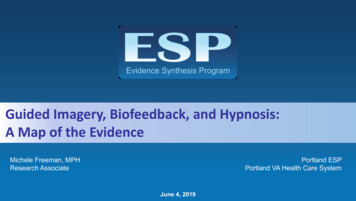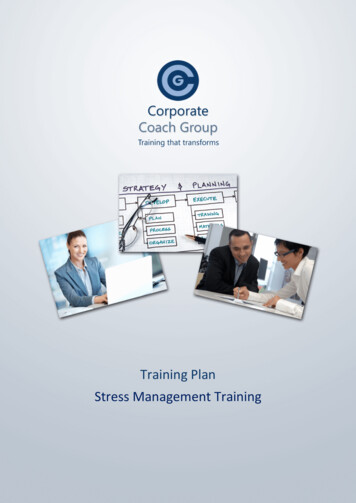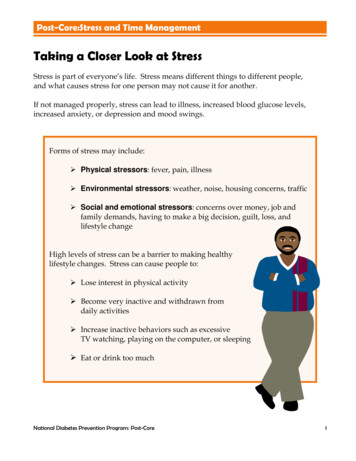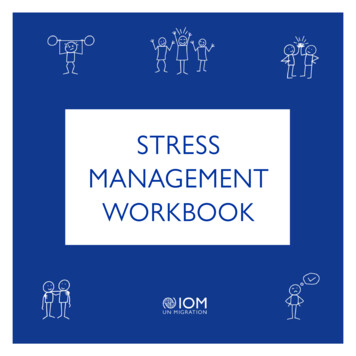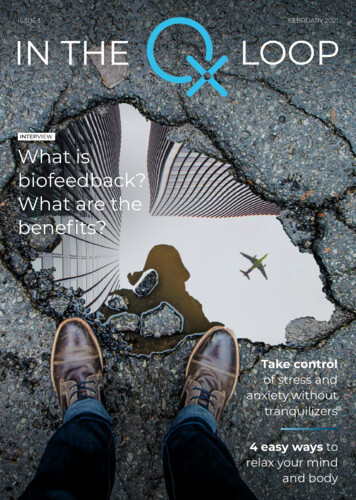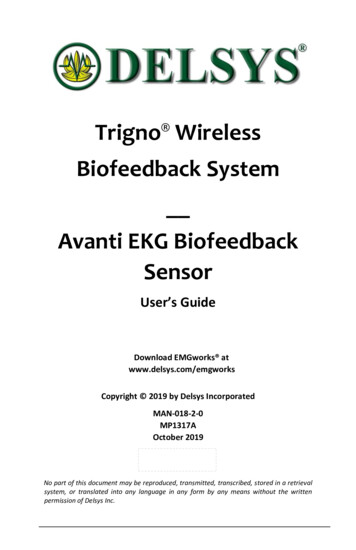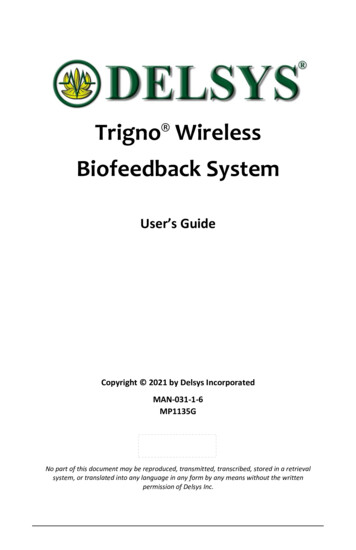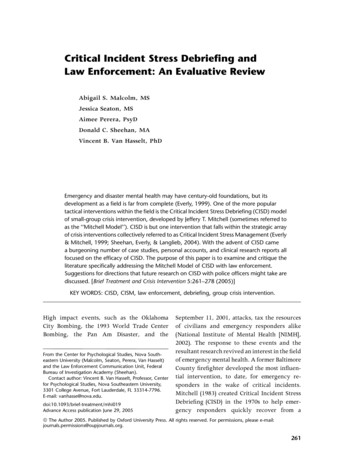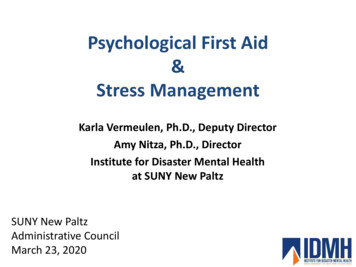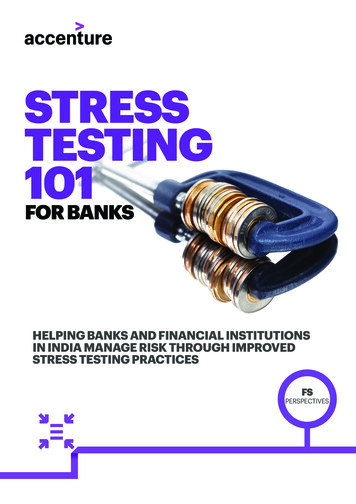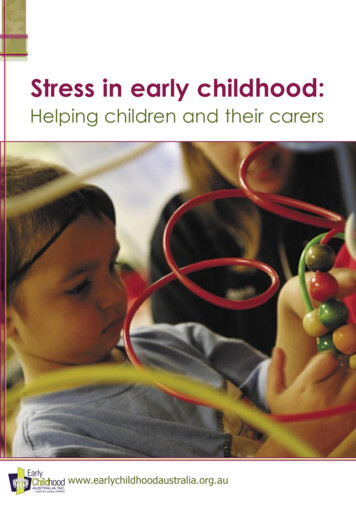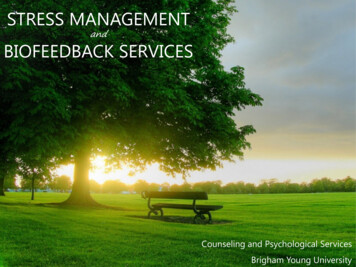
Transcription
STRESS MANAGEMENTandBIOFEEDBACK SERVICESCounseling and Psychological ServicesBrigham Young University
What is Biofeedback?Any Kind of Feedback From the Body- Biofeedback programs MEASURE stress indicators in the body- Biofeedback teaches AWARENESS of stress and tension- Biofeedback training can teach us to RELEASE tension and stress
Stress Response and Relaxation Response Stress Management is Like Learning to DriveOur stress response, the fight/flight/freeze response, islike a gas pedal that revs up our mind and body inreaction to stress as well as dangerOur relaxation response is like abrake that we can apply to calmdown when we are speeding outof control from stress
What Makes Stress Management So Difficult?Our inner gas pedal is Automatic We go from 0 to 100 in an instant inresponse to stressors Our mind does not differentiate dangerfrom stressOur inner brake is Not Automatic It takes awareness and practice to Catch ourselves “speeding” Develop skills to relax “at will” Maintain appropriate cruising speed Make braking more automatic
Stress and the Modern Student PRIMITIVE STRESS RESPONSE HIGHLY DEVELOPED BRAIN STRESSThe fight, flight, or freeze response becomes over-active andmaladaptive in our fast-paced modern world of constant stressorsThe stress response impairs our concentration, working memory,rational thinking and ability to functionOnly humans carry stress around: Stress comes from our worries, fears, expectations, regrets,self-criticisms, and negative perceptions Our stress level is determined more by our perception of thestressor than the stressor itselfWhat is supposed to be a burst of energy for survival results inchronic stress with many consequences for health and wellness
Stress and ak Performance Psychological Responses toStress Overload Anxiety, Nervousness, Worry Avoidance of Tasks (Flight) Decrease in Performance Emotions: Anger, Confusion, MediumLEVEL OF STRESSYerkes-Dodson PrincipleRobert M. Yerkes, M.D. and John D. Dodson, M.D, 1908HighDepression, Hopelessness, Sadness,Tearfulness (Fight or Flight) Feeling Overwhelmed (Freeze) Perfectionism Poor Concentration/Memory
Stress and the Mind/Body ConnectionUnstressed Mind and Body Breathing: Smooth, calm, slowBlood Pressure: Normal cardiac flowEmotions: Manageable, calm moodsHeart Rate: Steady circulation, oxygenHormones: Regulating normallyImmune System: Protecting the bodyMind: Focused, clear thinking, memoryMuscles: Contract as needed, then relaxStomach: Digesting normallySweat Glands: As needed to cool offStressed Mind and Body Breathing: Shallow and quickBlood Pressure: Increased cardiac outputEmotions: Fear, anger, panic, nervousnessHeart Rate: Speeds up to pump more bloodHormones: Adrenalin, cortisol, norepinephrineImmune System: Shuts down to save energyMind: Instinctive, higher thinking shuts downMuscles: Tense up, ready for actionStomach: Digestion shuts down;“butterflies”Sweat Glands: More active to cool the body
Why Zebras Don’t Get Ulcers, Anxiety, Insomnia. . .After they outrun the lion. . . . .they go back to grazing and playing.We need to stop running whenwe are not being chased!* Why Zebras Don’t Get Ulcers, Robert M. Sapolsky, 2004
Two Ways to Access Biofeedback ServicesOne-on-One Biofeedback Appointment Feedback from Stress Profile and recovery ratesDetermine personalized optimal breaths per minuteLearn mindfulness strategies and deep relaxationCustom-made relaxation recordingsMeasurement, assessment, training of mind and body stress factorsWalk-In Biofeedback Hours Learn diaphragmatic breathing (emWave)Class assignmentsListen to relaxation recordingsFun interactive biofeedback games on individual computer stationsIntensive relaxation trainingMindfulnessBrief and deep relaxation*The first 3 individuals are admitted each hour
Biofeedback Helps With These SymptomsPsychological SymptomsPhysiological Symptoms Anxiety (general/social/test) Concentration, forgetfulness Depression, tearfulness,hopeless Excessive worry or fear Irritable, angry Learning, memory Motivation, confidence Performance, give up Shame, overwhelmed Task avoidance, performance Chest tightness, racing heart Cool clammy hands,trembling Headaches, migraines Jaw tension and pain, TMJ Muscle tension Pain Panic attacks Poor circulation Sleep issues, fatigue Stomach issues, nausea, IBS
Start With Awareness Notice the Signs of StressMental and EmotionalPhysical Angry, Upset, Irritable Chest Pain or Tightness Anxious Cold and/or Sweaty Hands Avoid or Run From Tasks Muscle Tension Depressed Pounding Heart Mind Racing, Concentration Sleep Problems Overwhelmed, Helpless Stomach Discomfort Poor Concentration or Focus Trembling or Shaking
Heart Rate Variability (HRV) TrainingEmWave Computer Program Uses a simple breathing technique to quickly calm your mind and relaxyour body Encourages autonomic balance or coherence between stress and relaxation Learn to change your heart rhythm and heart pattern Also teaches diaphragmatic breathing for:- immediate calming- improved concentration, memory and mental clarity- peak performance- positive mental and emotional focusOther Fun Interactive Biofeedback Programs Dual Drive: Calm breathing wins the race Relaxing Rhythms: Games improve calmness, emotional balance, andmindful meditation
Additional Biofeedback MeasurementsMuscle Tension (EMG or Electromyography) We tend to brace against stress which can decrease bloodflow to our tissues Constant muscle tension can cause tightness, stiffness,tiredness, pain, headachesHand Temperature The stress response pumps blood to the large muscles, heart,lungs to power us up to run away or fight This decreases circulation to the hands and feet (makes extremities colder)and brain (poor concentration) Hand temperature can range from 68 to 98 Sweat Gland Activity (SR or Skin Response) Sweat glands are the most reactive indicator of stress inour body; stress causes our heart rate to increase andhormones to flood our body Known as the Galvanic (electric) Skin Response Measured as Skin Conductance or Skin Resistance
Brief RelaxationTap the brake throughout the day as neededto calm yourself when stressed Brings you back to peak performance Use techniques proactively to prevent stress overload Slow, low breathing every hour for a few minutesQuick body scan to prevent tension build-upStretch out your neck, arms and legsClose your eyes and take a mini mind vacation to arelaxing place or peaceful memory Use an app for a 2-minute meditation Once learned, any relaxation technique can be used as a brief technique
Deep RelaxationBring the car to a complete stopfor a needed break from stress10 Minutes or More Once a Day Conditions our mind and body toeffortlessly let go of tensionTeaches skills to more easily usebrief techniques throughout the dayProtects the immune systemHelps prevent or improve stressrelated health problems such ascardiac, blood pressure, IBS, etc.Improves mental health issues
Relaxation Skills PracticeThey are called skills because they take It takes only 10 Minutespractice like any other skilla Day to learn these skillsChoose a time that fits into your routine:MorningAfternoonBedtimeBreak From Studying
Effective Stress Management Effective BrakingWhenever we notice signs of stress, especially stressoverload, that is the time toPut on the Brake Ask for and allow helpBalance work and playBreatheCreate boundariesChange stress inducing thoughts tostress reducing thoughtsEat nutritiouslyExerciseMeditate and/or be mindfulRelaxSeek spiritual supportSocialize and enjoy relationships withfamily and friends
Resources and Practicecaps.byu.edu/biofeedback Make an AppointmentWalk-In HoursRelaxation RecordingsImportance of BreathingPaced BreathingHandoutsApps and WebsitesAdditional ResourcesYouTube ChannelMeet theTeamWhat is Biofeedback
Awareness Practice Effective Stress ManagementHow we can support you in using the KNOWLEDGEand SKILLS you learn here in your daily life We can help you chooseawareness and practice We can refer you toappropriate resources goals We can ask you aboutyour goals, progress, andstress when you returnWe can support you incustomizing biofeedbackand relaxation trainingfor your stress issues
Sweat Glands: More active to cool the body Breathing: Smooth, calm, slow Normal cardiac flow Manageable, calm moods Steady circulation, oxygen Hormones: Regulating normally Immune System: Protecting the body Mind: Focused, clear thinking, memory Muscles: Contract as needed, then relax Digesting normally
